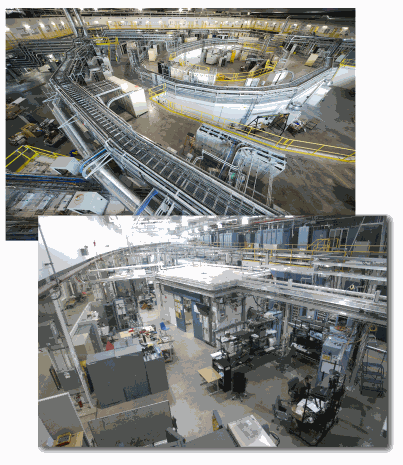The Canadian Light Source (CLS) and the Advanced Photon Source (APS) at the U.S. Department of Energy’s (DOE’s) Argonne National Laboratory agreed in January 2012 to a Partner User Proposal that cements a stronger working relationship between the two facilities for the next three years. These two premier light sources use different but complementary x-ray techniques to probe materials in order to understand chemical and structural behavior.
“The ravages of disease, the shortage of sustainable energy sources, and the need for high-performance materials cross all borders,” said Brian Stephenson, Argonne Associate Laboratory Director for Photon Sciences and APS Director. “By sharing technological expertise and offering scientists the complementary research techniques of the laboratories, we hope to more quickly discover answers to the challenges of our high-tech world.”
This new agreement will provide Canadian scientists with more research time to use the x-ray light source facilities and more time on a larger number of APS beamlines. Using varied x-ray and imaging capabilities will broaden the range of experiments Canadians may undertake at the APS to augment their research done at the Canadian Light Source. X-ray science offers potential solutions to a broad range of problems in surface, material, environmental and earth sciences, condensed matter physics, chemistry, and geosciences.
Since the Sector 20 beamlines became fully operational, scientists from Canada and other areas who have used these beamlines at the APS have produced an average of 51 scientific publications a year. This research includes the study of more effective mineral exploration strategies, ways to mitigate mine waste and mercury contamination, and novel ways to fabricate nanomaterials for use in fuel cells, batteries, and LEDs.
"Having secure access to brilliant beams of hard x-rays has allowed the CLS to concentrate our local efforts on those applications best suited to the performance characteristics of our lattice while continuing to support Canadian scientists in programs that are truly best served by doing the science at the CLS or the APS, whichever provides the best performance," said Josef Hormes, CLS Executive Director.
Before the Canadian Light Source began operation in 2004, a Canadian group led by Daryl Crozier of Simon Fraser University, working in partnership with colleagues at the University of Washington and the Pacific Northwest National Laboratory, helped found the Sector 20 beamlines at the APS as part of the Pacific Northwest Consortium Collaborative Access Team, or PNC-CAT. Parts of this team were included in the X-ray Science Division of the APS when it was formed.
This long-standing partnership has led to scientifically significant upgrades to the beamline. The new agreement will provide the valuable manpower and expertise to allow the APS to continue to push the innovation envelope.
Scientists from the APS and the Canadian Light Source will work together on R&D projects to improve light-source technology. In particular, scientists will upgrade even further the two beamlines at Sector 20 in four key areas. This will provide a unique capability to prepare and measure in situ films and interfaces, a new technique to create quantitative three-dimensional chemical maps of samples, and improved forms of spectroscopy to expand the range of elements and types of environments that can be examined.
“Canadian researchers have been strongly involved with the APS since its inception,” Stephenson said. “This expanded agreement builds on our long history of successful collaboration and promises a continued future of plentiful science results and technological innovations.”
— Tona Kunz
The Advanced Photon Source at Argonne National Laboratory is one of five national synchrotron radiation light sources supported by the U.S. Department of Energy’s Office of Science to carry out applied and basic research to understand, predict, and ultimately control matter and energy at the electronic, atomic, and molecular levels, provide the foundations for new energy technologies, and support DOE missions in energy, environment, and national security. To learn more about the Office of Science x-ray user facilities, visit http://science.energy.gov/user-facilities/basic-energy-sciences/.
Argonne National Laboratory seeks solutions to pressing national problems in science and technology. The nation's first national laboratory, Argonne conducts leading-edge basic and applied scientific research in virtually every scientific discipline. Argonne researchers work closely with researchers from hundreds of companies, universities, and federal, state and municipal agencies to help them solve their specific problems, advance America's scientific leadership and prepare the nation for a better future. With employees from more than 60 nations, Argonne is managed by UChicago Argonne, LLC for the U.S. Department of Energy's Office of Science.

